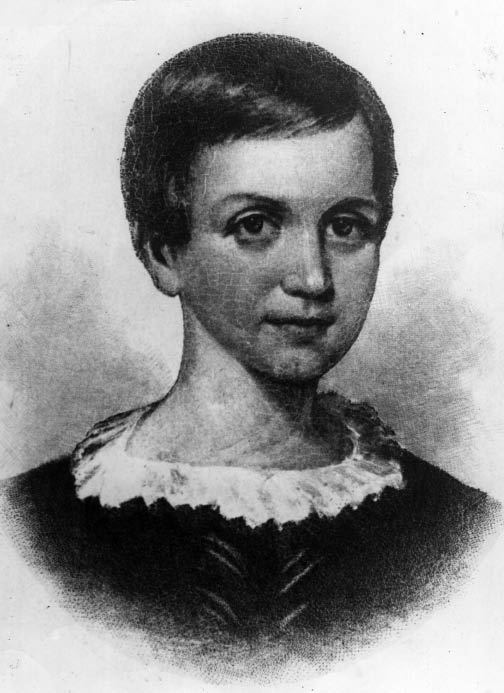For someone who barely left the house, Emily Dickinson didn’t half cause a lot of trouble.
For someone who barely left the house, Emily Dickinson didn’t half cause a lot of trouble. Lives Like Loaded Guns — which combines biographical material, critical readings, and an assessment of the history of her reputation — tells a completely hair-raising story.
The Dickinsons were one of the first families of respectable Amherst. Emily and her sister Lavinia — ‘Vinnie’ — lived in one house, Homestead, right next door to her brother Austin, the head of the family, and his wife Sue. Susan Dickinson was a highly intelligent and sensitive woman, bosom friend to Emily. The poet called her ‘Sister’.
The cataclysm came when Austin fell in love with an ambitious and sexually captivating married woman, Mabel Loomis Todd. Their affair split the family open. Austin and Mabel — with the connivance of Vinnie — started using Homestead to hold their assignations. Susan and her children were distraught, but their feelings were ignored.
Dour, ramrod-backed Austin started to record in his diary that he and Mabel had enjoyed ‘the most perfect = = = =’, or ‘at the other house 3 to 5 and + = = = = = X X X’. The latter entry is footnoted by Gordon’s admission that ‘not all the code signs can be interpreted’. But we can make a guess. The vulgar word for his condition is ‘c***-struck’.
The set-up was scandalous by any standards. The affair was carried on with the active encouragement of Mabel’s philandering husband David, and ‘group sex’, Gordon writes, might even have been part of the picture.
Mabel meanwhile made war on Susan. She schemed, ultimately unsuccessfully, to wrest Austin permanently from his wife. She persuaded him to let her build a house on their land, plonk next door to his family, and urged him to emotional cruelties that, she fantasised, might cause her rival to die of hurt. Mabel was a real piece of work: Gordon compares her to Lady Macbeth.
This cuckoo in the Dickinson nest was not only socially and sexually ambitious: she became determined to take control of Emily’s literary legacy. This, despite the fact that — far from being friends, as she later claimed — they never met face to face and Emily in life scorned as ‘snares’ Mabel’s overtures of friendship.
After Emily’s death, though, Lavinia (who inherited the poems) encouraged Mabel to edit the texts for publication, which she did brilliantly. But when she realised Lavinia had little intention of recognising her work, she and Austin turned on her, and after Austin in turn died, it got really nasty.
The copyrights and ownership of Dickinson’s manuscripts became the subject of vicious contention, and when Mabel tried to trick Lavinia into making yet more family land over to her, the whole thing ended up in court.
Amazingly, the bitterness of the feud continued even after Mabel, Sue and Vinnie were in their graves. Mabel’s daughter, Millicent, and Sue’s daughter, the flaky romantic novelist Mattie Dickinson, stepped up to take their mothers’ places in the lists.
The public understanding of Dickinson, for decades after her death, has been distorted by the fall-out from this feud — with accounts of her life and attachments twisted to serve one side or another, and her body of manuscripts divided.
Gordon’s project in this book is to unpick the knots and tangles of these competing myths. She does it brilliantly. She rescues Sue’s reputation from malign posterity, puts that jezebel Mabel — albeit not ungenerously — in her place, and most important, cuts through the cutesy cant that has cast Dickinson as demure, passive and unworldly. Dickinson is yet another woman writer — like her heroine Charlotte Bronte — whom posterity would not allow to be herself.
Gordon’s prose is engaged, partisan — often even a touch overripe for my taste. But that is a symptom of her deep imaginative immersion in Dickinson’s world and writing. She’s a sensitive reader of the verse, too — those breathy, dashy, pioneering examples of what Dickinson’s poetic descendent Stevie Smith would call ‘foot-off-the-ground’ writing.
A Dickinson poem can open out into any number of dramas to fill its compelling spaces,
writes Gordon.
As a woman unmodified by mating, a stranger to her time, speaking for those who are not members of the dominant group, Dickinson’s dashes push the language apart to open up the space where we live without language. This act of daring takes off from a logical argument along the tightrope of the quatrain. She flaunts her footsteps. Her poetic line is a high-wire act: a walker pretends to hesitate, stop and sway: then, fleet of foot, skips to the end.
There’s an awkward dangling modifier in that second sentence, and you wonder about the tightrope metaphor, but in its higgledy-piggledy way it evokes very well what it’s like reading a Dickinson poem. Talking about Dickinson’s disconcerting grammatical shifts — changing nouns into verbs, for instance — Gordon strays from the traditional literary criticism into neuroscience. I didn’t know, for instance, that research on Shakespeare’s grammatical repurposings seems to indicate that nouns and verbs are processed in different parts of the brain: ‘when the usual connection is challenged a new pathway opens up. A surge in the brain registers on an electro-encephalogram six-hundredth of a second after we hear a novelty of transformed grammar’.
That reference to ‘a surge in the brain’ echoes a Dickinson line about a ‘snarl in the brain’ — pointing to another of this book’s little scoops. Gordon argues persuasively that it wasn’t just shyness that confined Emily to her room: she suffered from epilepsy.
Her imagery — volcanoes and loaded guns — always signalled an explosive force beneath the tense surfaces of those poems. But in life, the image persists, here was a woman who flitted around the shadows of her New England house like a giant white moth, terrified of the world.
Gordon’s, instead, is a Dickinson of sharp and sour humour and of passionate, even earthy affections. Here is a Dickinson supremely confident in her poetic genius and not shy or afraid to publish — at various times, she bombarded publishers with poems, albeit she was painfully knocked by rejection.
Here, too, is a Dickinson who knew about sexual passion. The love of her life, Gordon argues, was Otis Phillips Lord, a judge in the Massachussetts Supreme Court who became a suitor after the death of his wife in 1877.
Her letters to Lord are rather more forthright than the legend of the Amherst spinster prepares you for: ‘when it is right I will lift the Bars, and lay you in the Moss’; ‘I confess that I love him — I rejoice that I love him — I thank the Maker of Heaven and Earth that gave him me to love — the Exaltation floods me — I cannot find my channel. The Creek turns Sea — at thought of thee… Incarcerate me in yourself.’
Even though Dickinson was 47 when she fell in love with Lord, the judge’s niece remembered her as a ‘little hussy’: ‘Loose morals… She was crazy about men. Even tried to get Judge Lord. Insane too.’
We’re still a way away, I think, from a general view of Emily Dickinson as a boy-crazed trollop: but by moving the general view a little way in that direction Lyndall Gordon has, oddly enough, done this great poet a favour.







Comments